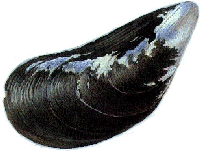Example: Marine Pollution
Example: Marine Pollution |
Click here to open an associated Mathcad worksheet: |

This example reviews the basics of entering data into an input table, plotting data and equations together, and finding a best-fitting line.
Tributyltin (TBT) is a chemical that is acutely toxic to many species of marine animals. Even small amounts of TBT can inhibit an organism's growth rate.
TBT is used in marine paints (e.g., on boat hulls) and in other "antifoulants." Shipyards, pleasure craft, commercial ship traffic, and wood and fishing net preservatives are all potential sources of TBT.
Members of the Bowdoin College Hydrocarbon Research Center and the Marine Research Laboratory conducted a study to learn about TBT in blue mussels (Mytilus edulis). Mussels were sampled from 15 coastal Maine intertidal locations (plus one location in England).
Shell thickness index (TI) was determined on a sample of animals collected from each site. (TI is a dimensionless quantity defined as 100 times shell thickness divided by shell length.) The concentration of TBT in the cell tissues (TBT) was measured in micrograms (mg) per gram of tissue. The data are given in the following table:
| TBT (mg/g) |
TI |
TBT (mg/g) |
TI | ||
| 0.04 | 0.40 | 1.66 | 0.50 | ||
| 0.11 | 0.42 | 3.56 | 0.56 | ||
| 0.50 | 0.43 | 0.27 | 0.48 | ||
| 0.60 | 0.43 | 0.45 | 0.45 | ||
| 0.73 | 0.46 | 0.74 | 0.44 | ||
| 0.77 | 0.46 | 1.75 | 0.48 | ||
| 1.75 | 0.48 | 0.04 | 0.42 | ||
| 4.31 | 0.53 | 0.04 | 0.39 |
For more information on mussels and marine pollution, read the National Oceanic and Atmospheric Administration (NOAA) summary of data from the National Shellfish Register.
|
|
|
| Back to Contents | |